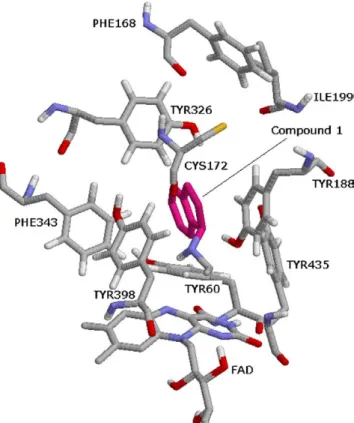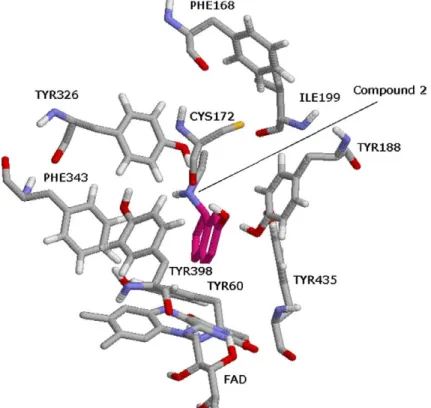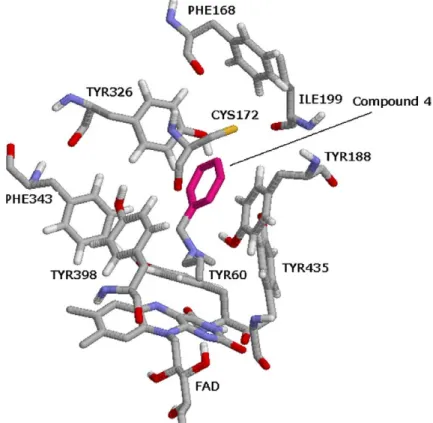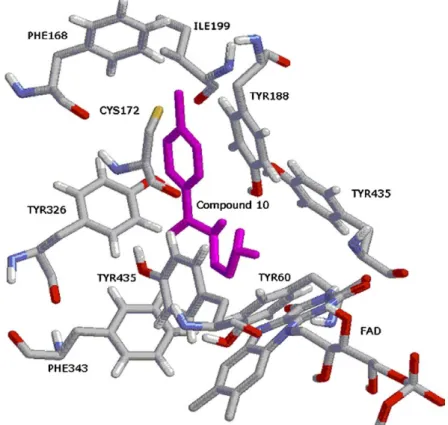Docking studies on monoamine oxidase-B inhibitors: Estimation
of inhibition constants (K
i
) of a series of experimentally
tested compounds
Mustafa Toprakc¸ı´
aand Kemal Yelekc¸i
b,*a
Department of Biochemistry, The School of Medicine, Kadir Has University, Hisaraltı´ Cad. 34230 Cibali-Fatih-Istanbul, Turkey b
The Faculty of Arts and Sciences, Kadir Has University, Hisaraltı´ Cad. 34230 Cibali-Fatih-Istanbul, Turkey
Received 11 May 2005; revised 11 July 2005; accepted 14 July 2005
Abstract—Monoamine oxidase (EC1.4.3.4; MAO) is a mitochondrial outer membrane flavoenzyme that catalyzes the oxidation of biogenic amines. It has two distinct isozymic forms designated MAO-A and MAO-B, each displaying different substrate and inhib-itor specificities. They are the well-known targets for antidepressant and neuroprotective drugs. Elucidation of the X-ray crystallo-graphic structure of MAO-B has opened the way for molecular modeling studies. A series of experimentally tested (1–10) model compounds has been docked computationally to the active site of the MAO-B enzyme. The AutoDock 3.0.5 program was employed to perform automated molecular docking. The free energies of binding (DG) and inhibition constants (Ki) of the docked compounds were calculated by the Lamarckian Genetic Algorithm (LGA) of AutoDock 3.0.5. Excellent to good correlations between the calculated and experimental Kivalues were obtained.
Ó 2005 Elsevier Ltd. All rights reserved.
1. Introduction
Monoamine oxidase (EC 1.4.3.4; MAO) is a flavoen-zyme that is important to the oxidative deamination of a variety of biogenic and diet-derived amines in both the central nervous system (CNS) and in the peripheral tissues.1,2
Compounds that inhibit MAO exhibit either antidepres-sant activity, if they inhibit the A isozyme,3or
antipar-kinsonian activity, if they inhibit the B isozyme.4 The
differentiating role of Ile335 in MAO-A and of Tyr326 in MAO-B in determining substrate and inhibitor spec-ificities in human MAO-A and -B has been experimen-tally demonstrated and the results have been published.5
Dopamine (DA), adrenaline, noradrenaline (NA), sero-tonin (5-HT), and b-phenylethylamine (PEA) are among the most important substrates for the enzyme in the CNS.
The important function of MAO in the catabolism of neuorogenic amines has attracted the interest of many researchers. The early MAO inhibitors (MAOIs) devel-oped for the treatment of depression were withdrawn from the market because of their severe side effects and irreversible binding mechanism.6 This problem
was alleviated with the discovery and development of selective and reversible MAOIs.7,8
Recent findings have shown that MAO-B inhibitors have neuroprotective9and antioxidant effects,10 as well
as a role in delaying apoptotic neuronal death.11
The development of a new generation of inhibitors has attracted the attention of many researchers working in the design, synthesis, and molecular modeling studies of reversible and selective inhibitors.12
The determination of the 3D structure of MAO-B by X-ray crystallography13has opened the way for
molecu-lar modeling studies.
To get some insight into the oxidation mechanism of MAO-B, a series of amino ethers was synthesized and tested with the enzyme MAO-B.14 Enzyme–adduct
models were also studied using the Self-consistent Field 0960-894X/$ - see front matter Ó 2005 Elsevier Ltd. All rights reserved.
doi:10.1016/j.bmcl.2005.07.043 Keywords: Docking; MAO-B inhibitors.
* Corresponding author. Tel.: +90 21 25 33 57 72; fax: +90 21 25 33 65 15; e-mail:yelekci@khas.edu.tr
theory, using a semi-empirical MP3 method and an ab initio method at the MP2/6-31G*//6-31G* level.15
The results of these studies and recently published16
arti-cles about the crystal structure of MAO-B have paved the way for applying computational chemistry to design better inhibitors of this enzyme. In this study, we aim to develop a docking simulation program for the MAO-B enzyme. AutoDock 3.0.516simulation program was
em-ployed to determine the binding orientation, free energy of binding, and inhibition constants (Ki) of several
experimentally tested MAO-B inhibitors (Table 1). The calculated and experimental inhibition constants of these compounds were then compared.
2. Methods 2.1. Protein setup
For the present study, two different crystal structures of MAO-B (1GOS, 1S3E) were used to test the validity of AutoDock 3.0.5 docking program.
2.2. 1GOS (3.0 A˚ resolution)
The crystal structure of Monoamine oxidase-B in com-plex with its inhibitor pargyline was obtained from the Protein Data Bank (PDB entry code 1GOS).17
MAO-B has two identical subunits (A and MAO-B). The study was carried out on only the B subunit of the enzyme protein. The pdb file was edited and the A-chain was removed together with the pargyline group, which was an irre-versible inhibitor of MAO-B. Atoms of the FAD cofac-tor were defined in their oxidized state.
For use with the Autodock docking simulation, all polar hydrogens were added with the GROMACS modeling package.18,19 The partial charges were placed using the
same package keeping FAD in an oxidized sate. The resulting structure was optimized in 400 steps of conju-gate gradient minimization, employing the GRO-MACS87 force field. During minimization, the heavy atoms were kept fixed at their initial crystal coordinates, but added hydrogens were made free to move. Minimi-zation was effected under a vacuum medium.
Electro-static interactions were calculated using the cut-off method. As the acceptable minimal force gradient was reached, the minimization converged and the resultant structure was saved. Finally, solvation parameters were added using the ADDSOL utility of AutoDock 3.0.5. Default values of atomic solvation parameters were used throughout the calculations. The grid maps of the pro-tein used in the docking experiments were calculated using the AutoGrid utility program.
2.3. 1S3E (1.6 A˚ resolution)
The high-resolution crystal structure of Monoamine oxi-dase-B, which co-crystalized with its irreversible inhibi-tor 6-hydroxy-N-propargyl-1(R)-aminoindan 2, was obtained from the Protein Data Bank (PDB entry code 1S3E).17 The same procedure was applied to a 1S3E
crystal structure as applied to 1GOS structure above, ex-cept that an additional side-chain optimization was per-formed. This treatment optimized the 1E3S structure further and the conformational changes resulting from binding of the original inhibitor in the crystal structure were partially removed.
2.4. Ligands
For docking experiments with AutoDock 3.0.5, ligand molecules were drawn, optimized, and saved as in mol2 format with the aid of Spartan20and VEGA
pro-grams.21 Full hydrogens were added to the ligands and
Gasteiger22partial atomic charges were computed using
the VEGA program and saved in the required format. All possible flexible torsions of the resultant ligand molecules were defined by using AUTOTORS. The prepared ligands were used as input files for AutoDock 3.0.5 in the next step.
2.5. Docking
Docking simulations were performed with AutoDock 3.0.5 using a Lamarckian genetic algorithm.23 The
standard docking procedure was used for a rigid pro-tein and a flexible ligand whose torsion angles were identified (for 10 independent runs per ligand). A grid of 60,60, and 60 points in x, y, and z directions was
Table 1. AutoDock estimated free energies of binding (DGb), calculated [Ki(calculated)] and experimental [Ki(experimental)] inhibition constants of the studied inhibitors (temperature = 298.15 K)
Inhibitors DGb(kcal/mol) (calculated)
Ki(lM) (calculated) Ki(lM) (experimental) Ref.
1GOS 1S3E 1GOS 1S3E
1 8.24 8.39 0.907 0.708 0.7 26 2 7.75 7.90 2.08 1.62 17 26 3 8.79 8.45 0.359 0.636 0.6 26 4 7.29 7.47 4.55 3.33 1.8 ± 0.20 27 5 8.38 8.22 0.717 0.946 0.97 ± 0.13 27 6 12.04 10.70 0.436 (nM) 10.2 (nM) 100 (nM) 28 7 9.63 9.38 0.0876 0.133 0.600 29 8 7.39 7.51 3.84 3.11 3.0 30 9 12.07 11.97 1.43 (nM) 1.67 (nM) 14 (nM) 31 10 8.10 8.33 1.16 0.781 0.084 32
built, centered on the center of the mass of the flavin (FAD) N5 atom on the catalytic site of the protein. A grid spacing of 0.375 A˚ and a distance-dependent function of the dielectric constant were used for the calculation of the energetic map. The default settings were used for all other parameters. At the end of docking, ligands with the most favorable free energy of binding were selected as the resultant complex structures. All calculations were carried out on PC-based machines running Linux x86 as operating sys-tems. The resultant structure files were analyzed using Rasmol24,25 visualization programs.
3. Results
Molecules 1–10 were successfully docked onto the ac-tive site of MAO-B, according to the above docking protocol. Table 1 shows the results of the docking experiments: calculated free energy of binding, inhibi-tion constants for each complex (with 1GOS and 1S3E), and their corresponding experimental inhibition constants. Rasagiline 1, N-propargyl-1(R)-aminoindan, was docked into the active site of the MAO-B enzyme
(Fig. 1). A careful inspection of the binding pocket
indicated that rasagiline adopted a position in a hydrophobic cage surrounded by Tyr398, Tyr435, Tyr188, Cys172, Tyr60, and Phe 343. The indan ring of rasagiline is perpendicular to the re face of the covalent FAD, which itself forms the amine binding site. The aromatic moiety of the rasagiline interacts
with the side chains of the residues of Tyr398, Tyr435, and p–p via Tyr188. The propargyl group of rasagiline was aligned on the N5 atom of the FAD. Cys172, Tyr60, and Phe343 also contributed some of the interactions to stabilize the complex.
Figure 2 shows
6-hydroxy-N-propargyl-1(R)-aminoin-dan 2 in the active site of the MAO-B enzyme. The indan ring was sandwiched between the Tyr398 and Tyr435. The 6-hydroxy group of the indan ring was positioned to make the hydrogen bond to Cys172 and Tyr435. The propargyl group of compound 2 was oriented a little further away compared to pound 1. The other principal interactions of com-pound 2 were the same as those of comcom-pound 1.
Figure 3 shows the final docked position of
N-meth-yl-N-propargyl-1(R)-aminoindan 3. In this case, the indan ring was oriented vertically in the hydrophobic cage on the re face of FAD. The propargyl group of indan is in close proximity to the N5 atom of the FAD. Pargyline (4) was docked, as shown in Figure 4. The phenyl ring of the pargyline was placed be-tween Tyr398 and Tyr188. The propargyl group ex-tends down from the phenyl ring to the re face of
FAD. Figure 5shows the binding pattern of selegyline
(l-deprenyl) 5. A similar binding behavior was ob-served fast as pargyline, except for the phenyl ring, which was bent backwards 90°. Another interesting molecule, 8-(3-chlorostyryl)-caffeine 6 which acts as a potent competitive MAO-B-specific inhibitor26, was
docked into the active site of the MAO-B enzyme, as shown in Figure 6. From the figure, one can see that the caffeine ring was positioned toward the re face of FAD. The 3-Chlorostyryl group extended away from the hydrophopic cage and was located between the residues Phe168, Tyr326, and Cys172. The 1,4-diphenyl-2-butene 7, which is a contaminant of polystyrene, was docked as shown in Figure 7. It was observed that the one of the phenyl moieties of compound 7 was positioned between Tyr398, Tyr435, and Tyr188 in the substrate cavity space. The other phenyl moiety made a strong p–p interaction with the residues of Phe168 and Tyr326. Apparently, the residue Ile199 may contribute to the binding and sta-bilization of these compounds in the entrance cavity space of MAO-B. The binding mode of reversible MAO-B inhibitor isatin (indol-2,3-dione) 8 is shown
in Figure 8. The 1S3E crystal structure picture is
visu-alized here. The indol ring of isatin was positioned be-tween Tyr435 and Tyr398 hydrophobic cage such that the amine group located itself on the re face of FAD cofactor. This position satisfied the minimum distance between isatinÕs nitrogen atom and FADÕs N5 atom.
Figure 9 shows the optimal binding mode of
3-meth-yl-8-(4,4,4-trifluoro-butoxy)indeno[1,2-c]pyridazin-5-one 9 with MAO-B (1S3E: 1.6 A˚ crystal structure resolu-tion). The indeno[1,2-c]pyridazin-5-one nucleus was sandwiched between Tyr398 and Tyr435. Hydrogen bondings between the carbonyl and pyridazine func-tional groups of indeno[1,2-c]pyridazin-5-one, and Tyr188, Tyr398, and Tyr435 are important, as well as the hydrophobic interaction. Trifluorobutoxy side chain extended itself along the entrance cavity. Final-ly, we performed docking of the reversible inhibitor Figure 1. Docking result of N-propargyl-1(R)-aminoindan 1
(Rasag-iline) with MAO-B. The inhibitor, FAD, and the important residues in the active site of the enzyme are presented by stick model.
Figure 2. The interacting mode of 6-hydroxy-N-propargyl-1(R)-aminoindan 2 in the active site of MAO-B enzyme.
lazabemide 10 into the active site of the MAO-B (1S3E) (Fig. 10). The docking study has revealed that lazebemide 10 localized its interaction with Tyr188. Its
p–p aromatic nucleus away from the FAD cofactor making side chain including primary amine and amide moiety was positioned in the vicinity of FAD cofactor Figure 4. The interacting mode of propargyline 4 and its alignment in the active site of the enzyme.
approaching the N5 atom of FAD cofactor as closely as possible (see Chart 1).
4. Discussion
The objective of this study was to implement an Auto-Dock simulation program to calculate the binding free energies and inhibition constants of experimentally test-ed MAO-B inhibitors and to compare these computa-tional results with those of the experimentally obtained results. Purified human recombinant MAO-B crystal structure (1GOS), with a 3.00 A˚ resolution, and crystal structure (1S3E) with a 1.60 A˚ resolution were used throughout the Autodock simulation study.13
Experi-mental inhibition constants were also obtained using this enzyme, 26 except in the case of compounds 427
and 5,27 whose experimental inhibition constants were
obtained using rat brain MAO-B.27Much better results
were obtained with a high-resolution crystal structure (1S3E) compared to the results using a 1GOS crystal structure. To check the versatility of the Autodock 3.0.5 docking program, both mechanism-based irrevers-ible and competitive reversirrevers-ible (7, 8, and 9) inhibitors were used as model compounds. Co-crystallization of mechanism-based irreversible inhibitors within the active site of both enzyme forms may cause some con-formational changes of the active site. After the removal of mechanism-based irreversible inhibitors from the active site of both enzyme forms, polar hydrogens were Figure 6. The interacting mode of 8-(3-chlorostyryl)-caffeine 6 with MAO-B. The important residues of the enzyme and the inhibitor are depicted by stick model.
Figure 7. The binding conformation of 1,4-diphenyl-2-butane 7 with MAO-B.
added and optimized. In the case of 1S3E, in addition to the polar hydrogens, the side chains of amino acids were also optimized to imitate the unbound conformation of the active site. The 1GOS results were given only for comparative purposes. Only high-resolution results will be discussed here. As seen from Table 1, an excellent correlation was observed between the estimated Ki
val-ues of compound 1, 3, 5, and 830, and their experimental
inhibition constants. Reasonable values of estimated inhibition constants were obtained in the case of com-pounds 2, 4, 6, 7, 931, and 10.32Compound 2 10.2-fold,
compound 6 9.8-fold, compound 7 4.5-fold, and com-pound 9 8.4-fold have lower Kivalues than that of the
experimental values. Compound 4 has a 1.7-fold and compound 10 9.3-fold have higher Ki values than that
of the experimental values. It was experimentally deter-mined that MAO-B from different species does not exhibit the same inhibitor specificities for a particular inhibitor. In this study, we used recombinant human MAO-B crystal structure. However, as some of the available experimental results were obtained on MAO-B isolated from different species. With regard to the re-sults obtained for compounds 1, 3, 5, and 8, in favorable cases, excellent correlations seem to be possible. Howev-er, in some other cases an acceptable agreement with the reported results was obtained. This might be the result of simplifications used in the AutoDock program: no explicit water molecules are considered during docking, and solvation and entropic effects were not taken into account. The orientations of these inhibitors in the Figure 8. The binding conformation of indol-2,3-dione (isatin) 7 with MAO-B (1S3E: 1.6 A˚ resolution).
Figure 9. The binding conformation of 3-methyl-8-(4,4,4-trifluoro-butoxy)indeno[1,2-c]pyridazin-5-one 9 with MAO-B (1S3E: 1.6 A˚ resolution).
Figure 10. The binding conformation of lazabemide 10 with MAO-B (1S3E: 1.6 A˚ resolution). N CH3 CH3 H H N CH3 N H C H N H C H HO N C H H3C N N N N Cl C H3 CH3 O CH3 O H N O O H N N O O F3C CH3 N Cl N NH2 O H C Selegiline ( l- deprenyl) (5) C Pargyline [ Benzyl(methyl)prop-2-ynylamine ] (4) 6-hydroxy-N-propargyl-1(R)-aminoindan (2) N-methyl-N-propargyl-1(R)-aminoindan (3) N-propargyl-1(R)-aminoindan (Rasagiline) (1) 1,4-Diphenyl-1,3-butadiene (7) 8-(3-Chlorostrylyl)caffeine (6)
Indol -2,3-dione (Isatin) (8)
3-Methyl-8-(4,4,4-trifluoro-butoxy)indeno[1.2-c]pyridazin-5-one (9)
Lazebemide (10)
active site are also very important, with their Ki values, for rational drug design. Careful observations of the fig-ures reveal that in most of the cases, inhibitor position-ing in the active site sits reasonably well. The data obtained by the AutoDock studies here are thought to be important for our continuing research efforts in the design and synthesis of new, selective, and reversible inhibitors for MAO-B.
5. Conclusions
Ten MAO-B inhibitors were successfully docked onto the active site of purified recombinant human MAO-B enzyme. The free energy of binding and the inhibition constant of each complex were calculated using the Autodock 3.0.5 docking program. The obtained Ki
val-ues of 10 experimentally tested inhibitors agree reason-ably well with previous data in the literature on the inhibition of MAO-B. These studies provide us with an important approach for predicting the inhibition constants of newly designed and previously untested MAO-B inhibitors.
Acknowledgments
We thank Prof. Artur J. Olsen for his kindness in letting us use the Autodock 3.0.5 simulation program. We would also like to acknowledge Kadir Has University for providing us its computational facility for this study.
References and notes
1. Bach, A. W. J.; Lan, N. C.; Johnson, D. L.; Abell, C. W.; Bembenek, M. E.; Kwan, S. W.; Seeburg, P. H.; Shih, J. C. Proc. Natl. Acad. Sci. U.S.A. 1998, 85, 4934.
2. Shih, J.; Chen, K.; Ridd, M. J. Annu. Rev. Neurosci. 1999, 22, 197.
3. Binda, C.; Hubalek, F.; Li, M.; Herzig, Y.; Sterling, J.; Edmondson, D. E.; Mattevi, A. J. Med.Chem. 2004, 47, 1767.
4. Tetrud, J. W.; Langston, J. M. Science 1989, 245, 519. 5. Geha, R. M.; Rebrin, I.; Chen, K.; Shih, J. C. J. Biol.
Chem. 2001, 276, 9877.
6. Brunello, N.; Langer, S.; Perez, J.; Racagani, G. Depres-sion 1995, 2, 119.
7. Haefely, W.; Burkard, W. P.; Cesura, A. M.; Kettler, R.; Lorez, H. P.; Martin, J. R.; Richards, J. G.; Scherschilicht, R.; Da Prada, M. Psychopharmacology (Berl) 1992, 106(Suppl.), S6.
8. Cesura, A. M.; Pletscher, A. Prog. Drug. Res. 1992, 38, 171.
9. Mason, R. P.; Olmstead, E. G., Jr.; Jacob, R. F. Biochem. Pharmacol. 2000, 60, 709.
10. Sloley, B. D.; Urichuk, L. J.; Morley, P.; Durkin, J.; Shan, J. J.; Pang, P. K.; Coutts, R. T. J. Pharm. Pharmacol. 2000, 52, 451.
11. Tatton, W. G.; Chalmers-Redman, R. M.; Yu, W. Y.; Wadia, J.; Tatton, N. A. J. Neural Transm. Suppl. 1997, 49, 245.
12. Mana, F.; Chimenti, F.; Bolasco, A.; Secci, D.; Bizzarri, B.; Befani, O.; Turini, P.; Mondovi, B.; Alcaro, S.; Tafi, A. Bioorg. Med. Chem. Lett. 2002, 12, 3629.
13. Binda, C.; Newton-Vinson, P.; Hubalek, F.; Edmondson, D. E.; Mattevi, A. Nat. Struct. Biol. 2002, 9, 22.
14. Yelekc¸i, K.; Silverman, R. B. J. Enzyme Inhibition 1998, 13, 31.
15. Erdem, S. S.; Yelekc¸i, K. J. Mol. Struct. (THEOCHEM) 2001, 572, 97.
16. Morris, G.; Goodsell, D.; Huey, R.; Hart, W.; Halliday, S.; Belew, R.; Olson, A., Autodock 3.0.5 UserÕs Guide, 1998, p. 86. (http://www.scripps.edu/pub/olson-web/doc/ Autodock/).
17. http://www.rcsb.org/pdb/:MAO-B(PDBId.1GOS). 18. Berendsen, H. J. C.; van der Spoel, D.; van Drunen, R.
Comp. Phys. Commun. 1995, 91, 56.
19. Lindahl, E.; Hess, B.; van der Spoel, D. J. Mol. Mod. 2001, 7, 317.
20. SpartanÕ02, Wavefunction, Inc. Irvine, CA.
21. Pedretti, A.; Villa, L.; Vistoli, G. J.C.A.M.D. 2004, 18, 167.
22. Gasteiger, J.; Marsili, M. Tetrahedron 1980, 36, 3219. 23. Morris, G. M.; Goodsell, D. S.; Halliday, R. S.; Huey, R.;
Hart, W. E.; Belew, R. K.; Olson, A. J. J. Comput. Chem. 1998, 19, 1639.
24. Sayle, R.; Milner-White, E. J. Trends Biochem. Sci. (TIBS) 1995, 20, 374.
25. Herbert, J. B. Trends Biochem. Sci. (TIBS) 2000, 25, 453– 455.
26. Hubalek, F.; Binda, C.; Li, M.; Herzig, Y.; Sterling, J.; Youdim, M. B. H.; Edmondson, D. E. J. Med. Chem. 2004, 47, 1760.
27. Fowler, C. F.; Mantle, T. J.; Tipton, K. F. Biochem. Pharm. 1982, 31, 3555.
28. Hubalek, F.; Binda, C.; Khalil, A.; Li, M.; Mattevi, A.; Castagnoli, N.; Edmondson, D. E. J. Biol. Chem. 2005, 16, 15761.
29. Hubalek, F.; Binda, C.; Li, M.; Mattevi, A.; Edmondson, D. E. Acta Crystalogr. Sect. D 2003, 59, 1874.
30. Binda, C.; Li, M.; Hubalek, F.; Nadia, R.; Edmondson, D. E.; Mattevi, A. Proc. Natl. Acad. Sci. U.S.A. (PANAS) 2003, 100, 9750.
31. Ooms, F.; Fredrick, R.; Durant, F.; Petzer, J. P.; Castagnoli, N.; Van der Schyf, C.; Wouters, J. Bioorg. Med. Chem. Lett. 2003, 13, 69.
32. Cesura, A. M.; Gottowik, J.; Lahm, H. W.; Lang, G.; Imhof, R.; Malherbe, P.; Ro¨thlisberger, U.; Da Prada, M. Eur. J. Biochem. 1996, 236, 996.
![Table 1. AutoDock estimated free energies of binding (DG b ), calculated [K i (calculated)] and experimental [K i (experimental)] inhibition constants of the studied inhibitors (temperature = 298.15 K)](https://thumb-eu.123doks.com/thumbv2/9libnet/4322278.70839/2.892.67.818.899.1113/estimated-calculated-calculated-experimental-experimental-inhibition-inhibitors-temperature.webp)




![Figure 9. The binding conformation of 3-methyl-8-(4,4,4-trifluoro- 3-methyl-8-(4,4,4-trifluoro-butoxy)indeno[1,2-c]pyridazin-5-one 9 with MAO-B (1S3E: 1.6 A˚ resolution).](https://thumb-eu.123doks.com/thumbv2/9libnet/4322278.70839/7.892.239.669.100.570/figure-binding-conformation-trifluoro-trifluoro-indeno-pyridazin-resolution.webp)
